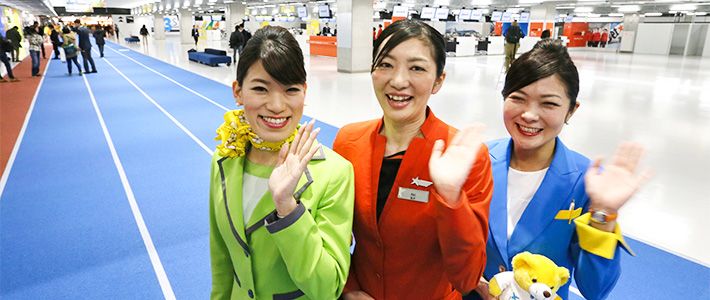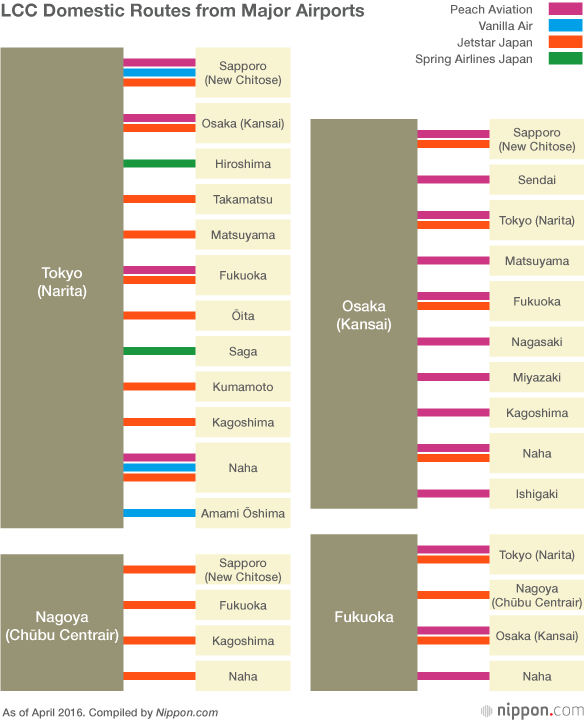
Low-Cost Carriers Set for 10% Domestic Flight Share
Economy- English
- 日本語
- 简体字
- 繁體字
- Français
- Español
- العربية
- Русский
New Entrants Follow Peach Aviation
Air passenger transport in Japan has long been dominated by the full-service carriers Japan Airlines and All Nippon Airways, which retain a near monopoly on domestic flights. Deregulation in the second half of the 1990s enabled such airlines as Skymark and Air Do to enter the market with a business model of low airfares similar to low-cost carriers. The major carriers, however, responded with discount flights, and the new entrants struggled in many cases.
The government deregulated air transport further in 2007. Based on the Asia Gateway Initiative of the first administration of Abe Shinzō, restrictions were lifted on foreign airlines offering flights to and from airports outside of the Tokyo metropolitan area. With the bankruptcy of JAL in 2010, the continuation of many domestic regional routes came under scrutiny. As a result, the government moved to promote the entry of LCCs.
The founding year for Japanese LCCs was 2012, with Peach Aviation, the first domestic LCC, beginning operations in March, followed by Jetstar Japan taking to the air in July.
LCCs Offering Domestic Flights in Japan
| Base Airport | Aircraft in Use | Start of Service | |
|---|---|---|---|
| Peach Aviation | Kansai, Naha, Narita | Airbus A320 | March 2012 |
| Vanilla Air | Narita | Airbus A320 | December 2013 |
| Jetstar Japan | Narita, Kansai | Airbus A320 | July 2012 |
| Spring Airlines Japan | Narita | Boeing 737 | August 2014 |
| AirAsia Japan | Chūbu Centrair | Airbus A320 | Summer 2016 |
| (New entrant airlines) | |||
| Skymark | Haneda, Kobe | Boeing 737 | September 1998 |
| Air Do | Haneda, New Chitose | Boeing 767 and 737 | December 1998 |
| Solaseed Air | Haneda, Naha | Boeing 737 | August 2002 |
| StarFlyer | Kitakyūshū | Airbus A320 | March 2006 |

Development of Special-Purpose Terminals
According to the Ministry of Land, Infrastructure, Transport, and Tourism, the LCC share of domestic air travel rose from 2.1% in 2012 to 5.8% in 2013. This figure climbed to 7.6% in 2014, surpassing the 7.5% share of international flights held by discount carriers.
Kansai International Airport opened a special-purpose LCC terminal in 2012, followed by Narita International Airport in 2015. By reducing costs through no-frills facilities, these terminals are contributing to the growth of LCC flights. Kansai International Airport is planning to open a new LCC terminal for international flights in spring 2017. Chūbu Centrair International Airport has also decided to build an LCC terminal.
Narita, Kansai, and Chubu the Main Bases
Unlike the situation for major airlines and existing new entrants, Japan’s LCCs do not have runway slots at Tokyo’s Haneda Airport, where domestic routes are concentrated. Instead, their main home bases are Narita and Kansai, making them convenient for fliers coming from overseas to make transfers once they arrive in Japan.
Peach Aviation , based at Kansai International Airport, was established by ANA and a Hong Kong investment company. It has 14 domestic routes and operates 9 international routes from Kansai and Haneda to such destinations as Taiwan and South Korea. The airline is managed independently of ANA, and it has generated new demand among young people through low airfares.
Jetstar Japan has JAL, Qantas, and Mitsubishi Corporation as its major shareholders. The airline offers 17 domestic routes from Narita and Kansai, as well as international flights connecting Japan with Hong Kong and Taiwan.
Vanilla Air is a consolidated subsidiary of ANA. It operates three domestic routes connecting Narita with Amami, Naha, and Sapporo. The airline also offers international flights from Narita to Taiwan and Hong Kong.
Spring Airlines Japan is an affiliate of Spring Airlines, a Chinese LCC. It operates two routes in Japan connecting Narita with Hiroshima and Saga. It has two international routes linking Narita to Wuhan and Chongqing in China. Spring Airlines provides many routes between China and Asian cities, a network representing a major business advantage for the carrier.
AirAsia Japan was established in 2014, led by Malaysian LCC AirAsia with capital participation from several Japanese companies, including Rakuten. It is based at Chūbu Centrair International Airport. Two domestic routes connecting Chūbu to Sapporo and Sendai and one international route from Chūbu to Taipei are scheduled to begin operating in summer 2016. The airline also plans to offer flights to China and Hawaii.
(Originally written in Japanese by the Nippon.com editorial department. Banner photo: Right to left, employees of Vanilla Air, Jetstar Japan, and Spring Airlines Japan wave at Narita International Airport’s Terminal 3 for LCCs. © Jiji.)